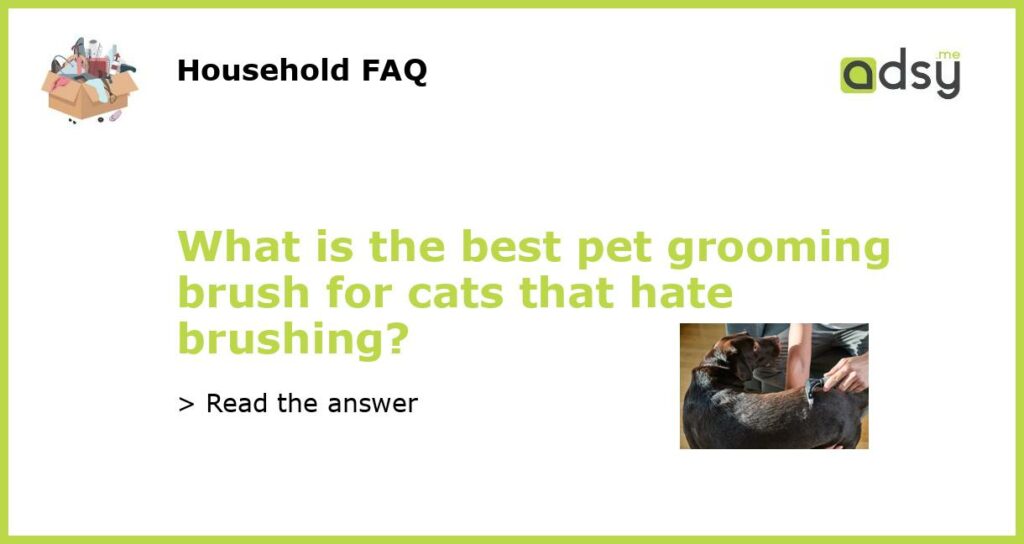Understanding the Struggle: Why Do Cats Hate Brushing?
Grooming is an essential part of a cat’s health and well-being. Regular brushing helps to remove loose fur, prevent matting, and promote a healthy coat. However, many cat owners find themselves facing a common challenge – their cats hate brushing. So why do cats have so much aversion to this grooming process?
One possible reason is that cats are highly sensitive to touch. They have a layer of sensitive whiskers on their faces and bodies that can get stimulated easily. The sensation of brushing may feel uncomfortable or even painful to them. Cats are also known for their independent nature, and they don’t particularly enjoy being restrained or handled.
Another reason is that cats groom themselves naturally using their tongues, which have tiny backward-facing barbs that help remove loose fur. They may see brushing as an unnecessary intrusion or a threat to their self-grooming routine. Furthermore, some cats may have had negative experiences with brushing in the past, making them associate the activity with discomfort or fear.
The Best Brush for Cats that Hate Brushing: The Deshedding Tool
When it comes to choosing the best grooming brush for cats that hate brushing, one type stands out – the deshedding tool. This specialized brush is designed to remove loose fur and minimize shedding, making it ideal for cats who dread the brushing process.
The deshedding tool works by gently removing the loose undercoat without cutting or damaging the topcoat. Its unique design features a wide, stainless steel comb with short teeth that effectively reach through the topcoat to remove loose fur from the underlying layers. This helps prevent matting and reduces the amount of shedding hair that ends up on your furniture.
Many cat owners have found success with popular deshedding tools like the FURminator. This brand offers a range of grooming tools specifically designed for cats, including the FURminator Undercoat deShedding Tool. It’s important to choose a deshedding tool that is appropriate for your cat’s size and coat length to ensure optimal results.
Tips for Introducing the Deshedding Tool to Your Cat
Introducing a new grooming tool to a cat that hates brushing can be challenging. However, with patience and a positive approach, you can make the process easier and more enjoyable for both you and your furry friend. Here are some tips to help you get started:
- Start slow: Begin by allowing your cat to sniff and investigate the deshedding tool without using it. This will help them become familiar with its presence and scent.
- Positive reinforcement: Reward your cat with treats, praise, or playtime whenever they show interest in or approach the deshedding tool. This will create positive associations with the tool.
- Gradual introduction: Once your cat is comfortable with the tool’s presence, gently start brushing small areas for short durations. Gradually increase the time and surface area as your cat becomes more accustomed to the sensation.
- Listen to your cat: Pay attention to your cat’s body language and cues. If they start showing signs of stress or discomfort, take a break and try again later. It’s important not to force the process.
- Make it a bonding experience: Use the grooming session as an opportunity to bond with your cat. Speak softly, pet them gently, and offer soothing words to create a positive and calming environment.
Additional Tools and Techniques to Aid the Brushing Process
In addition to the deshedding tool, there are other grooming aids and techniques that can help make the brushing process less stressful for cats that hate brushing:
- Gentle slicker brush: A slicker brush with soft, gentle bristles can be used to remove tangles and smooth the coat after using the deshedding tool. It’s important to choose a brush with flexible bristles to avoid causing discomfort.
- Treat-dispensing toys: Use treat-dispensing toys or puzzle feeders to distract and engage your cat during the grooming session. This can help redirect their focus and create a positive association with the activity.
- Frequent short sessions: Instead of trying to brush your cat for a long period of time, break the grooming sessions into shorter, more frequent intervals. This can help prevent your cat from becoming overwhelmed or agitated.
- Consider professional grooming: If your cat’s aversion to brushing persists despite your efforts, consider seeking professional grooming services. Groomers are experienced in handling cats and may be able to provide a more positive grooming experience.
The Importance of Patience and Understanding
It’s essential to approach the grooming process with patience, understanding, and empathy. Every cat is unique, and their preferences and tolerances can vary. Respect your cat’s limits and be mindful of their signals of discomfort or stress.
Remember, grooming should be a positive experience for both you and your cat. By choosing the right brush, introducing it gradually, and using additional aids and techniques, you can help your cat overcome their aversion to brushing and maintain a healthy, well-groomed coat.






